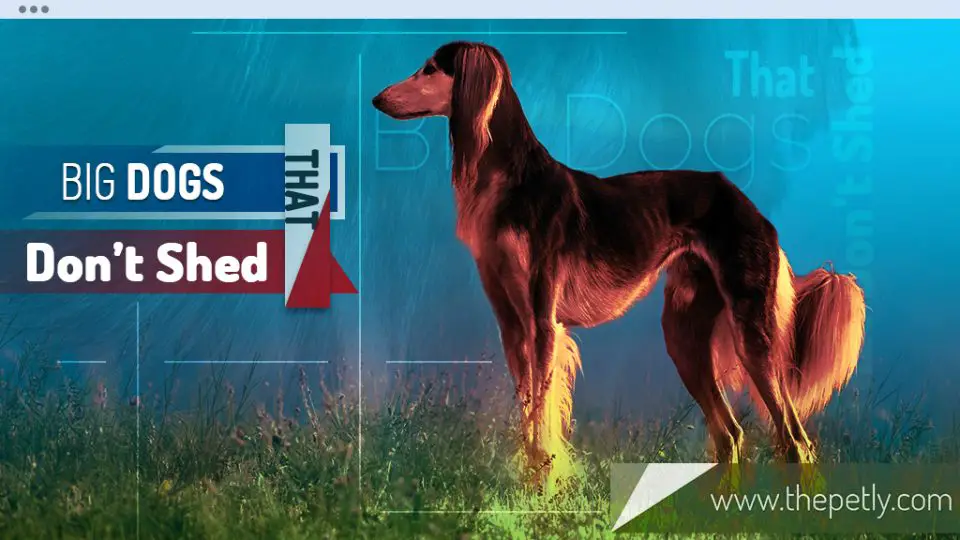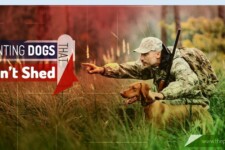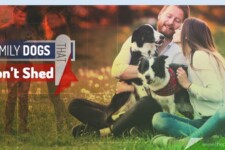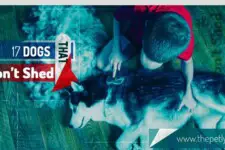6 Large Dogs That Dont Shed (Hypoallergenic Dog Breeds)
If you’re like me, then you just love large dogs – they are amazing animals with a wonderful temperament to match.
Around 15 to 30% of Americans suffer from allergy issues, and even if it’s not specifically you, it may be your spouse or children with sensitivities.
If you are in this group you might not be interested in just any dog, but a large dog that doesn’t shed.

Less shedding means less allergens, and since many adult large dog breeds are generally calmer than small dogs, they won’t spread dander and dirt to the same degree.
There may be many reasons that point you in this direction, but here are a few that may get you thinking:
1. You have allergies and you can’t stand anything that is a carrier of dirt and dust, or will aid in the spreading of allergens.
2. You are a clean-freak! So you can’t stand anything that brings dirt into your home, let alone rubbing it on your clothing.
3. You have young children who may be more susceptible to increased allergens in the home.
4. House cleaning is not your favorite past-time! So you don’t want to be constantly cleaning up dog hair.
Having looked at some reasons you may be interested in this type of dog, let’s first understand how and why dogs shed. We will then look at some good breeds, and ways you can help them shed minimally.
Understanding Dog Shedding
It is a fact that shedding is a big factor when deciding which dog to own.
Unfortunately there is no such thing as a dog that doesn’t shed at all.
One way or another your dog will drop some hair, but some dogs shed much less than others.
Three Main Reasons for Dogs Shedding
In most cases, the level of shedding depends on the dog’s breed, health, and the season.
Although there are other reasons that may result in shedding, these three remain the top causes of shedding.
The Breed
Different breeds of dogs have different types of coats.
For instance, a Belgian Malinois sheds very little, while in contrast a breed like a Golden Retriever has a thick coat, and will shed all year round regardless of the season.
If you want a low shedding dog, then start with a breed that suits your lifestyle and is known as a hypoallergenic breed as your starting point.
Skin And Health Issues
If your dog is suffering from skin issues you may see heavier shedding than normal.
This can be caused by parasites such as lice or fleas, or could be something more serious such as dermatitis, ringworm, or even skin cancer.
Fretting And Stress
Sometimes a dog can even shed excessively due to fretting or stress.
If they are fearful of certain situations or the current environment they are placed in, such as a boarding kennel, having someone absent in the immediate family, or even a vet visit.
Seasonal Factors
The ever changing seasons are another main reason for higher shedding.
During Spring and summer you will find that dogs shed more due to the onset of warmer weather.
This is a way that a dog naturally regulates its body temperature. In contrast, during colder seasons a dog’s fur will thicken to form a tighter coat to protect itself from the cold.
List of Big Dogs That Don’t Shed
1. The Standard Poodle

The poodle is a fun-loving dog that many people describe as intelligent, mischievous, friendly, loyal and very loving.
If you are worried about its behavior in an apartment, fear not – a Poodle can live in any type of house ranging from an apartment to an estate.
Poodles prefer to stay indoors, however they require regular exercise and companionship.
Like the rest of the dogs in this list, a Standard Poodle dog does not shed.
However, they do require regular grooming and brushing to keep them healthy, clean, and happy.
2. The Bouvier Des Flandres.

If you are looking for a laid-back dog which prefers quiet over silly antics, then this is your dog.
It is an intelligent, agile, compact, and powerful dog which is very light on its feet. The Bouvier was originally bred as a working dog.
In early days, they worked on farms with butchers and cattlemen. As you can guess about their brevity, they also make excellent guard dogs and police dogs.
Bouvier’s early name Vuilbaard (dirty beard) should give you an idea of how much grooming this dog requires.
So, make sure you are ready for regular grooming before you get this dog.
Nevertheless, you’ll find it comfortable when it comes to living with it if you are worried about dogs that shed.
3. The Saluki

The Saluki is characterized by devotion to family and it does not like strangers.
Unlike a lap dog that enjoys cuddling and sitting on your lap, a Saluki is more independent as it prefers sitting by your side, and have a quiet and gentle nature.
Salukis come in various colors like white, red, tri-color, grizzle, cream, black, and tan.
Maintenance of its coat is not overbearing, all they need is normal grooming to keep them clean and with a healthy shiny coat.
If you consider owning this independent breed, you should know that it makes a better watchdog than a protection dog.
4. The Giant Schnauzer

Before you decide to get a Giant Schnauzer, make sure you are ready to deal with a dog whose intelligence is above average, leading sometimes to stubbornness.
Because of these qualities, it equally needs an intelligent, creative, and firm owner – a leader to counter its mischief.
If you want to instill and maintain good manners, then consistent training is a must.
Although it does not shed a lot, this dog requires regular grooming to keep it looking at its best.
When grooming, you will need to brush its fur and legs regularly. And don’t forget to wash their beard after meals if you want to keep them especially clean.
On final count, Schnauzers are very protective of their families, affectionate, and enjoy being the center of attention.
5. The Goldendoodle

A Goldendoodle is a hybrid of the poodle and the Golden Retriever.
It is friendly, gentle, patient, and a highly affectionate dog which enjoys spending time with humans.
It can be mischievous and playful but very loyal when trained well.
Goldendoodles have longer hair on the tail, body, ears, and legs plus a non-shedding wavy-curly coat of about 2-3 inches that requires grooming to keep it in the best possible condition.
They have a black, white, cream, red, golden, apricot, copper or golden coat (the most common).
6. The Komondor

With a long and noble history of being a flock-guarding dog in his native country Hungary, the Komondor makes an excellent protective dog.
A male Komondor grows up to 27.5 inches and weighs 100 or more pounds while the female is 25.5 inches and 80 or more pounds.
The dog’s large size, independence, slow maturity, and aggressiveness – especially to other dogs, make them a bad choice for timid or first-time owners.
Komondor’s cords require regular grooming, and you will need to separate the cords frequently to remove dirt and avoid matting (if they are frequently outdoors).
You can choose to trim the cord around their mouth to avoid staining from food.
Make sure you are also prepared to spare a whole day bathing and drying the cords.
Check out this video about Komondor dogs…
See More Of Our Low Shedding Dog Series
Does Dog Shedding Cause Allergies?
As we all know, the effect of an allergic reaction to dogs may range from subtle to severe depending on the sensitivity of a person.
Even though there is a correlation between dog shedding and allergies, the reality is that allergies are not directly caused by hair your dog sheds. Instead, the main culprits can be factors such as urine, saliva, or dander.
The problem generally lies with the excretion of a dog’s proteins, and also the external environment of the dog such as grass seeds, pollen, dust, and dirt.
Normally it is harmless to the dog, but to certain people, it may lead to an undesired immune reaction.
Among the ways a dog can directly cause allergies, dander is the most common.
Here Is Why…
In its physical form dander is powdery, and it is released as the result of losing dead skin and regenerating new skin cells.
At this stage it easily spreads through the air, and drops on surfaces within the house.
As you move around, the contaminants get stirred up into the air constantly, meaning that you breathe them in.
One way to help clean the air in your house is to get an air purifier. You can find out more about air purifiers and how they can help in this article.
You should also note that spreading of dander or dead skin is rampant among dogs with thicker coats that shed more heavily.
For hypoallergenic dog breeds this problem is obviously reduced.
If you are an outdoor person your dog may act as a pollen collection agent, and like dander it is also spreads easily.
In most cases, it happens when you take a trip to the woods or the garden accompanied by your dog.
The normal drill goes like this.
- You walk or play with your dog in the forest.
- Your dog rubs against bushes, and rolls in grass and dirt.
- The dog’s fur traps pollen spores.
- When you return home from your exploration, your dog innocently brings these elements back into your house.
Tips For Reducing Dog Hair Allergy Issues
Please note that this information is intended as general knowledge. The following is NOT medical advice – for specific information relating to your own personal health please seek advice from professionally accredited medical practitioners.
As we said earlier, there is no dog which is shed-proof, so you will still need to deal with issues of hair in your house, clothes, and dog bedding to some degree.
Train Your Dog To Obey No-Dog-Zones
This means you should have at least one space that is dog free. If your allergy is the problem, you should train your dog to keep out of areas like your bedroom, and off your lounge.
Use An Air Purifier
Use an air purifier fitted with HEPA filters – this kind of purifier helps to remove allergens from the air in your home.
Clean Your Carpet Regularly
Ensure you own a good quality carpet vacuum cleaner to get stubborn dog hair out of carpet and off upholstery.
A good vacuum cleaner will also have a fine particulate filter that traps fine dust such as dog dander.
As well as vacuuming your carpet, it’s a good idea to steam-clean your carpets regularly, as this removes dried saliva and urine which can also cause allergy symptoms.
Check out our article that looks at good carpet cleaning machines for houses with pets.
You can also read about some effective carpet cleaning shampoo brands that will clean up ground-in pet related grime.
Wash Your Clothes Regularly
Every interaction with your dog will lead a few hairs and allergens sticking to your clothes.
This will lead to your clothes harboring dander and dust, and can increase allergy problems. So to prevent this wash your clothes before returning them to your closet.
Keep Your Dog Clean
As you might guess, grooming goes beyond brushing or bathing. It also includes activities like tidying your dogs bedding.
When required, you should wash your favorite pooch with a good quality dog shampoo.
Check out our post that takes a close look at anti-itch dog shampoos that help reduce shedding.
Wash Your Hands Regularly
With the advent of covid-19 (coronavirus) we are all far more aware of the need to wash our hands regularly.
After interacting with your dog it is best you wash your hands with soap and water, or if they aren’t available, then some antibacterial hand wipes.
Having clean hands means you won’t inadvertently be rubbing allergens in your eyes, or on your face.
Washing A Big Dog – Some Tips
Washing a large dog can be a tedious task that is most likely going to consume a lot of your time. It is highly likely that your dog will not fit in the bathtub!
Train them how to bath outside when they are still young, and keep their leash on, this will help them adapt to this type of bathing.
Before your dog takes a bath, brush your dog’s coat to remove matted hair and make sure you rinse shampoo off thoroughly to avoid skin irritation.
If your dog is double coated, it is going to be difficult to get the soap into their fur.
Two rounds of diluted shampoo instead of one are not only easier, but it also makes rinsing less problematic and leaves your dog so much cleaner.
It is also very important to trim your dog’s nails. Do it frequently, ideally a couple of times per month to get the best results.
Health And Nutrition For Big Dogs
Big dogs require a different type of care, needing a larger space to play, more exercise time, and training compared to small dogs.
They are also susceptible to joint and other health conditions because of their body size.
Hip dysplasia is one critical health concern you should pay attention to if you are considering getting a large dog.
- This hereditary disorder leads to malformed hips which cause intense pain to the dog and can also cause osteoarthritis.
- You can avoid getting a dog with hip dysplasia by checking the hip certificates and learning more about the dog’s family tree.
You can also help minimize your dog’s suffering by:
- Avoiding strenuous exercise.
- Control your dog’s food intake to maintain a healthy weight.
- Ask your veterinarian for advice on the best course of treatment.
Other health concerns that big dogs are prone to are ulcers, cancer, and epilepsy.
Pay close attention to your dog so that you can catch symptoms early and have a better chance to treat your dog.
Whether you have a large or medium or small dog, your dog’s nutritional needs should be a priority.
One major concern should be preventing health issues that result from a dog being overweight, or anything relating to poor quality or incorrect food.
Therefore, if you own a big dog, it is important you stick to its feeding habits, nutritional requirements, and steer away from habits of overfeeding.
This is paramount to support a steady rate of growth over its lifespan.
Quick Tips About How To Treat Your Big Dog
Training A Big Dog
Training is most important for dogs, but is even more important for big dogs.
A large dog translates to more energy and power.
Without training it, you may have to deal with issues like aggression, anxiety problems, and lack of obedience further down the track.
Start training your big dog when it is still a pup, and take it through a series of positive reinforcement, and leadership skills.
More importantly if you are going to take your dog to public places, give it socialization trips frequently.
Through this training, your dog will learn to be calm and used to people. As always, a calm dog is less likely to hurt anyone.
Treats And Equipment For Big Dogs
Another aspect of having a big dog is that it requires big everything!
For instance, a bigger living space, transport, and even more food. Even their toys and beds also have to match their size.
So make sure you plan ahead for that extra penny you will have to spend to ensure that your dog lives as comfortable as possible.
Read about some good indestructible dog bedding choices, and we also have a post about chew toys for dogs who are heavy chewers.
Final Thoughts
Keep in mind that big dogs have a shorter lifespan compared to small dogs, so make sure you enjoy the precious time you have with yours.
As we’ve discussed, big dogs like any other breed of dog needs special attention to detail, so be proactive and try to learn as much as possible about them.
Pay close attention to their behaviors. Pay a regular visits to your vet. Pay attention to the efforts you are giving towards ensuring the best pet care for your favorite large doggy friend.
Sources
https://www.petmd.com/dog/conditions/neurological/c_dg_seizures_convulsions



